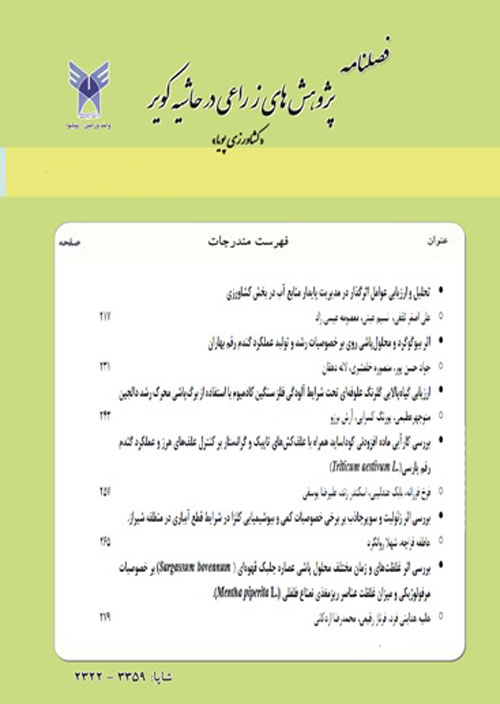The effect of micronutrients (Fe, Zn and Mn) on the quantity and quality of the Stevia (Stevia rebaudiana Bertoni)
Author(s):
Abstract:
In order to evaluate the effect of micronutrients (Fe, Zn and Mn) on the quantity and quality of the Stevia, an experiment was conducted in during 2014 at Research Greenhouse of Faculty of Agriculture, Islamic Azad University, Varamin branch. A randomized complete block design with three replications was used. Treatments included: 1-Control, 2-Foliar application (9% Fe water-soluble), 3- Foliar application (6% Fe water-soluble), 4- Foliar application (9% Fe water-soluble) Zn, 5- Foliar application (6% Fe watersoluble) Zn, 6-Foliar application (9% Fe water-soluble) Mn, 7- Foliar application (6% Fe watersoluble) Mn, 8- Foliar application (9% Fe water-soluble) Zn, 9- Foliar application (6% Fe watersoluble) Zn. Results showed a significant effect of Foliar micronutrients on shoot length, Internode length, root dry weight, leaf dry weight, soot dry weight, Stevioside, Rebaudioside, Glycoside, chlorophyll a, chlorophyll b, total chlorophyll, chlorophyll b/a, Fe, Zn and Mn content, but the effect of Treatments on P and Ca content is not significant. The Best Results in Foliar application (9% Fe water-soluble) Zn treatment was obtained. The impact on the amount of phosphorus and calcium treatments were not significant. Because the micro-nutrients applied as foliar application is sent, an increased impact on soil phosphorus and phosphorus absorption and thus no plant phosphorus content is also due to the lack of elemental calcium treatments and applications by spraying, can have no effect on the absorption of calcium soil. Most of the glycosides in the treatment of iron (nine percent soluble in water) Zn Mn and lowest in control 7.55 and 3.94 respectively with an average of dry matter was obtained. Most of the shoot in the treatment of iron (nine percent soluble in water) Zn Mn and lowest in control respectively 81 and 58 cm respectively. Fe Zn Mn combination treatment compared to other treatments bigger share of Stevia in the lengthening of internodes were at least internode length, with an average of 3.03 inches was in control. Lowest Steviosid with an average of 2.25% of dry matter in the Amdo control Fe Zn Mn combination treatment compared to other treatments had a bigger share in the increase in the Stevia plant Steviosid. The highest Rybvdyvzyd in the treatment of iron (nine percent soluble in water) Zn Mn and iron treatment (six percent soluble in water) Zn Mn with an average of 2.63 and 2.53 percent of the dry matter and least control it. In between treatments, foliar iron (not water-soluble iron content) Zinc foliar fertilizer spray six thousand four hundred manganese fertilizers more effective than other treatments the traits were measured.
Keywords:
Stevia , Foliar application , Fe , Zinc , Mn
Language:
Persian
Published:
Iranian Journal of Dynamic Agriculture, Volume:13 Issue: 4, 2017
Page:
275
magiran.com/p1745492
دانلود و مطالعه متن این مقاله با یکی از روشهای زیر امکان پذیر است:
اشتراک شخصی
با عضویت و پرداخت آنلاین حق اشتراک یکساله به مبلغ 1,390,000ريال میتوانید 70 عنوان مطلب دانلود کنید!
اشتراک سازمانی
به کتابخانه دانشگاه یا محل کار خود پیشنهاد کنید تا اشتراک سازمانی این پایگاه را برای دسترسی نامحدود همه کاربران به متن مطالب تهیه نمایند!
توجه!
- حق عضویت دریافتی صرف حمایت از نشریات عضو و نگهداری، تکمیل و توسعه مگیران میشود.
- پرداخت حق اشتراک و دانلود مقالات اجازه بازنشر آن در سایر رسانههای چاپی و دیجیتال را به کاربر نمیدهد.
In order to view content subscription is required
Personal subscription
Subscribe magiran.com for 70 € euros via PayPal and download 70 articles during a year.
Organization subscription
Please contact us to subscribe your university or library for unlimited access!


